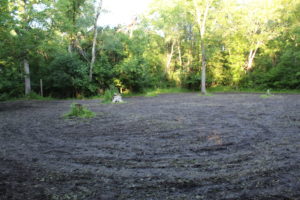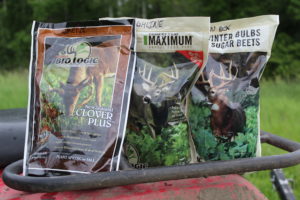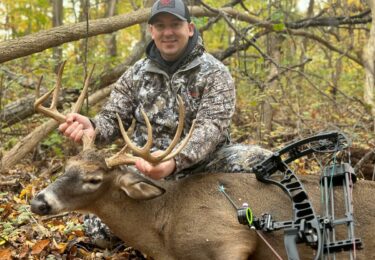Anyone that follows hunting on TV or social media has seen footage and pictures of sportsmen and women planting massive food plots every spring in their expensive, brand-new utility tractors with rotary tillers, full size plows, grain drills and the works. They look amazing and it makes me jealous. The truth of the matter though, is that the overwhelming majority of us outdoors folk can’t afford to drop thousands of dollars on even a cheap used tractor, much less all of the elements that go with it.
 Once you get past the equipment, you still have the seed, soil, fertilizer, and weed killer (if necessary) to worry about as well. Pretty much every food plot seed company offers their own complete start to finish lines that cover all the bases, but they can sometimes add up quickly. Years of planting using a wide variety of methods with an even wider variety of results have all lead to this list on how an Average Joe can get professional results and hopefully save enough greenbacks that you can maybe even squeeze in an extra plot or two. I know I’m late to the spring planting party, but life happens. Plus, there’s always fall plots and upcoming years to plan for!
Once you get past the equipment, you still have the seed, soil, fertilizer, and weed killer (if necessary) to worry about as well. Pretty much every food plot seed company offers their own complete start to finish lines that cover all the bases, but they can sometimes add up quickly. Years of planting using a wide variety of methods with an even wider variety of results have all lead to this list on how an Average Joe can get professional results and hopefully save enough greenbacks that you can maybe even squeeze in an extra plot or two. I know I’m late to the spring planting party, but life happens. Plus, there’s always fall plots and upcoming years to plan for!
EQUIPMENT
If you’re lucky enough to have a nice utility tractor with all the bells and whistles, you do you Boo Boo. For us ballers on a budget though, we’re usually left with the rent or borrow option. If you got a buddy that has everything you need AND lets you borrow it, hold on to them and never let go. If you don’t, local equipment rental stores are a fine choice and generally offer anything you might need or want, but an often overlooked resource is the local wildlife and habitat conservation chapters. Quality Deer Management Association, National Wild Turkey Federation, Pheasants/Quail Forever, Ducks Unlimited, and even local Soil and Water Conservation offices all participate in habitat restoration and often have their own equipment that they rent out regardless of membership status at a very reduced rate. For example, my local PF chapter has a pull behind Plot Master 400 that they rent out at $30 for a full day! Not only is that extremely cheap, but it is a great machine that can do it all. Going that route, you also know that your dollars are going directly back into conservation at a local level.
Sweat equity and elbow grease don’t cost a dime. It might be nice to buy that big hopper broadcast spreader that mounts to the back of your four wheeler, but the $40 push version and some tread off your boots can do just as good of a job in most cases. The same goes for clearing out old plots or starting new ones. You could rent a bush hog and a tractor or skidloader, but in many cases a weed whacker and some heavy duty string can do the trick. Plus, as an added bonus, victory will taste so much sweeter once you loose your arrow on a deer or send some T shot at a turkey’s melon after how much blood, sweat, and beers you put into it.
SOIL/LIME/FERTILIZER
Before planting a single seed or spreading an ounce of fertilizer, the very first step should always be a pH test. A ton of the big name food plot seed companies sell pH meters or kits that you can mail in, usually in the $15-$30 range if you shop around online. Ideally, for most food plot type plants a 6.0-7.0 pH will work perfectly fine. A ton of people think that you can just fertilize a plot into growing, but you can’t. If the pH of your soil is off, the plants won’t be able to absorb nutrients from the ground as efficiently as they should, and a portion of every dollar spent on fertilizer is blowing away in the wind. To get the most bang for your buck you need to get that pH level in the sweet spot, which is most times done by applying lime. Pelletized lime is extremely cheap, usually under $5 per 40lb bag at most hardware or farm supply stores, and it can be spread with just a simple broadcast or drop spreader. It can take up to 6 months to actually take effect in the soil, so it should be spread well before planting. You could also use hydrated lime which works almost immediately, but it’s more expensive and we’re going the cheap route here.
One benefit of getting a soil sample analyzed is that you get a much more in depth report than a number on a digital pH meter. Most Soil and Water or Ag departments are able to run these tests and can break down exactly how much lime you will need, and NPK ratio you will need in your fertilizer to maximize growth. Fertilizer is always labeled in a XX-XX-XX format that stands for percent of nitrogen (N), phosphorous (P), and potassium (K) in that order. If the numbers don’t add up to 100%, that’s because the rest is filler material to help with even distribution. Biologic, Whitetail Institute, Imperial Whitetail, etc. all sell their own blends of fertilizer specific to their seed. However, if you ran a soil test, you can save money by having your local farmer’s co-op or farm supply store mix it for you. Chances are it will be more effective as well, considering it is tailored specifically for the ground you tested which helps your hard earned dollars go further.
If you were forced to choose between fertilizer and lime, lime would be the best option. It is cheaper, and your plots will be able to get more out of the soil itself. Not to mention if you can do both, the fertilizer will work much better with a proper pH level as well.
SEED
 Almost all of the big name companies have spent years and a ton of money on research and development in the mixes that they put on the shelves, and people buy them because they work. Seed from some of these producers can seem expensive, but ask a farmer and they will tell you that compared to what they plant in their huge fields, it’s not that far off. This is one area where I try not to skimp depending on what I’m planting, because I have been burned in the past. It seems like a great idea to buy the $10 throw-and-go bag, but when you end up reseeding it two or three times because it didn’t take, you could have bought a higher end seed and had a couple less headaches. Many of the varieties of clover, chicory, and brassicas that the big guys offer are not commercially available either.
Almost all of the big name companies have spent years and a ton of money on research and development in the mixes that they put on the shelves, and people buy them because they work. Seed from some of these producers can seem expensive, but ask a farmer and they will tell you that compared to what they plant in their huge fields, it’s not that far off. This is one area where I try not to skimp depending on what I’m planting, because I have been burned in the past. It seems like a great idea to buy the $10 throw-and-go bag, but when you end up reseeding it two or three times because it didn’t take, you could have bought a higher end seed and had a couple less headaches. Many of the varieties of clover, chicory, and brassicas that the big guys offer are not commercially available either.
Choosing what type of seed to plant is a very important decision for a few reasons:
- Longevity and maintenance is key to saving money. Blends with a high percentage of perennials like clover, chicory, and alfalfa work great across the entire country. Best part about them is that once they are established, they require little care to stay attractive to both deer and turkeys other than mowing and will continue to grow back for years. Be careful not to mow it down too low however, as it can make deer that had been frequenting the plot look elsewhere for food and it gives weeds a chance to grow back. Mowing is a necessary evil though, because if the plants get to large or old they lose their attractiveness. If you have a couple of smaller perennial plots, you can try alternate moving them to try and direct deer to a specific plot while still leaving a good food source.
- Deer season is usually only a handful of months in most places. That leaves a lot of down time to chase other species around. Finding blends that cater to multiple species can be hard, but the ones that do work like gangbusters. Sorghum is an often disregarded for deer because although they will eat it, they generally only will in the very late winter. However, it works incredible as a screen crop that helps deer feel protected while feeding in the open and I have even had them bed in it. It is also one of the best crops you can plant for pheasants. It provides food and shelter and will attract and hold them year round. Turkeys will feed on it too, making it a great triple threat!
- Many deer hunters will spend all season waiting for that one specific hit list buck to walk by. Some might sit all season just waiting for A deer to walk by. Others might shoot the first deer that walks by. If I’m going to spend the time and money clearing out, plowing, planting, fertilizing, and maintaining a plot, I want to be able to hunt it the whole season. A couple blends I’ve had great success with is Biologic’s New Zealand Maximum and their Winter Bulbs and Sugar Beets. Deer will eat the greens as fast as they can grow in some places and will continue to dig up the bulbs and beets well after first frost, even digging through the snow in the ultra late season when perennials go dormant.
I would never buy sushi from a gas station because it’s cheaper than the restaurant, but sometimes if you work a little harder and think a little longer you can save money and still come out just fine.


